Updated School Design in a Post-Pandemic World
Restroom Safety
School restrooms have garnered a good bit of attention lately, not only for health but also for safety, particularly in terms of gender identification and separation in some locations. Among the strategies that have been proposed and carried out in response, those that promote high degrees of privacy in toilet stalls appear to be most successful. Fortunately, there are products available to help architects achieve the needed separation in ways that offer design options and cost-effective designs.
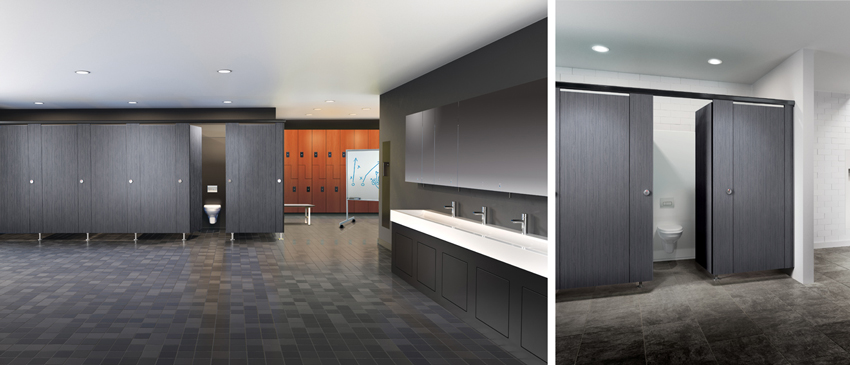
Photos courtesy of ASI Group
The use of taller, full-height partitions provides complete privacy in restrooms and can be selected from standard products to coordinate with the rest of the room design.
Toilet Stall Privacy
Common toilet partitions in the United States typically do not extend all the way to the floor or to the ceiling. Similarly, the doors to the partitions fit loosely, often creating a gap between the door and the pilaster, producing unintended sightlines into the stalls. These gaps are often a function of small changes in wall distances, some improper installation, or even incorrect measurement on the front end. By contrast, European toilet stalls are routinely characterized by extended height partitions and doors that overlap with the pilasters to close and lock without any sightline gaps or crevices.
Manufacturers of toilet partitions are now offering extended-height metal partitions in the United States, along with door solutions pre-built into the door, that afford complete privacy in toilet stalls. Furthermore, these can be utilized without sacrificing aesthetics, since they offer a range of materials, colors, and finishes. This helps with creating a cohesive look in a school by using products for a restroom or locker room that have similar design sensibility and color palate.
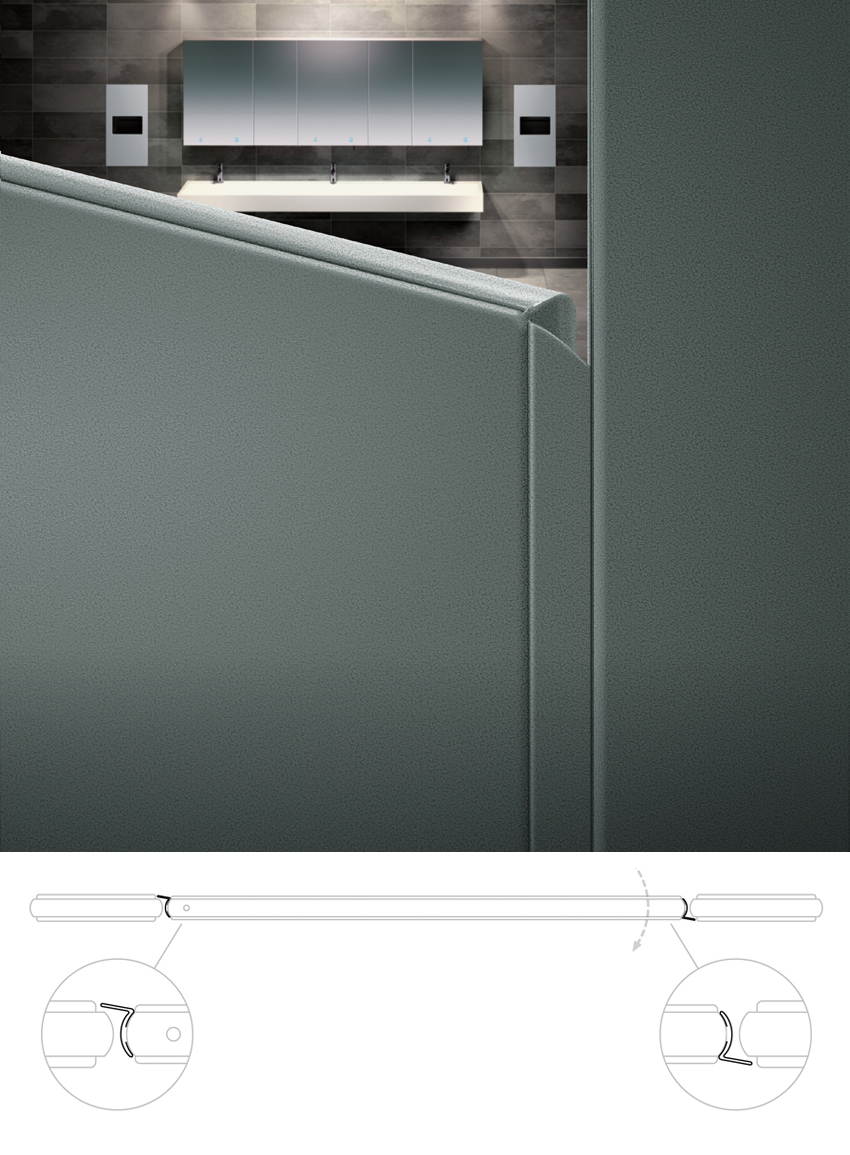
Photos courtesy of ASI Group
Full privacy is assured with manufactured components that match the rest of the system and are designed to cover any potential sightline openings.
Extended height partitions are available that have zero sightlines into the stalls and create a safer feeling with regard to the bathroom experience. Many different partition height options are also available, with different methods to eliminate sightlines. This privacy can be achieved by selecting from a variety of materials that also address appearance, functionality, hygiene, and durability. Solid plastic high density polyethylene (HDPE) or phenolic products are particularly appropriate for wet / humid environments like locker rooms or aquatic facilities, or even stadiums, where restrooms have to be hosed down completely from time to time. Powder-coated steel or stainless-steel partitions have been typically used for common areas where water and humidity are less of a concern. Similarly, plastic laminate partitions have been used as a cost-effective solution with a variety of design appearances that can transcend an institutional look by incorporating wood grain, colors, etc. To ensure a longer life for plastic laminate partitions, one company uses a special edge-banding process to guard against moisture penetrating the joints in the partitions. This also allows for an extended warranty on this product.
Some school facilities have addressed the privacy concerns by adding or retrofitting pieces onto existing toilet partitions and stalls, often with unsatisfactory aesthetic results as well as additional material and labor costs. One company has solved this problem by integrating privacy components into the doors so that no retrofitting is needed and with no additional cost to the school The guiding principles of the integrated privacy design are to meet an occupant’s need for total privacy while also being more aesthetically pleasing than using retrofitted privacy components that don’t match the stall. The built-in privacy components completely close the gap on the latch and hinge side of the door to guarantee zero sightlines into the stall. These components, color-matched to the rest of the stall, create a sense of continuity from the partition door to the pilasters. In addition, an occupancy indicator latch is now available as a standard feature. Some are also available with a uniquely designed stainless-steel pilaster shoe that simplifies the installation process. Altogether, these systems provide an attractive, durable solution that meets the demand for both old and new social boundaries.
Cyrus Boatwalla, director of marketing at the ASI Group, explains these guiding principles in more detail, “Our built-in need for privacy is laid bare in public washrooms, most of which are designed for multiple users and simultaneous use. Today, more than ever, our need to feel safe is paramount, and this can cause public washrooms to bring out deep-rooted fears, which may manifest in a visceral response. While some people may be mildly bothered by the thought of using a public washroom, others are paralyzed by the prospect—to the point that they cannot use the washroom while others occupy it.” These observations are true for adults, but also for many students in schools, too, particularly those who experience anxiety or fear of bullying of any kind.
Hygienic Restrooms
Although the COVID-19 pandemic lingers on, most students and staff have returned to school buildings. However, everyone involved is generally expecting more from such high-traffic, shared facilities. A manufacturer’s research study done with U.S. high school students in 2020 found that within the school building, the top three places that students are most concerned about coming into contact with germs are: school restrooms (63%); classrooms (50%); and the cafeteria (42%). Restrooms in particular seem to be the most scrutinized by students, teachers, and staff for being clean, hygienic, functional, and accessible. Furthermore, a related study found that 50% of high school students in the U.S. rate their school restroom facilities as poor or fair, while only 6% describe them as excellent. High school students’ top suggestions for school restroom improvement are: 1) cleaner restrooms that are stocked more frequently with soap, paper towels, and toilet paper, and 2) restrooms in which everything is touchless – with reliable technology.
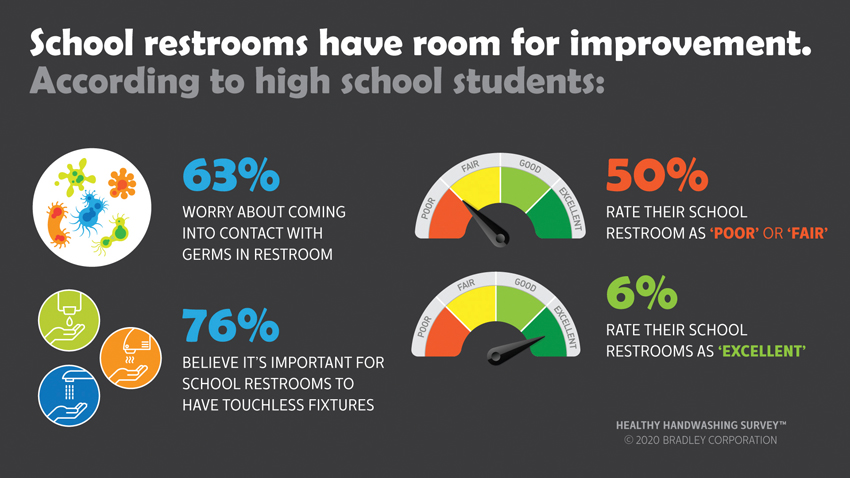
Image courtesy of Bradley Corp.
According to high school students, there is room for improvement in school restrooms. Fifty percent of students in the U.S. rate their high school restroom facilities as poor or fair, while only 6 percent describe them as excellent.
The results of these surveys are not surprising since restrooms are unique in that they are tight, enclosed spaces, have multiple touchpoints (about 10 in a single visit), and utilize water and paper products that can potentially create mess, slips and falls, and breed bacteria. The design question then becomes how does one create a hygienic and safe environment equipped to handle everyday usage, curb cross contamination of germs and increase handwashing activity by students, faculty, administration, and staff? Relatedly, how can the restroom experience be improved to make it more appealing, accessible, and safe for its users?
Touchless Fixtures
One strategy to help with hygiene in school restrooms is to install touchless fixtures. Sensor-activated handwashing and drying equipment addresses infection control, hygiene, accessibility, ease-of-use, maintenance, consumer demand, and cost-effectiveness. Cross contamination of germs in restrooms can be reduced by using touch-free fixtures for everything from soap, faucets, hand dryers/towels, doors, and flushers. The hands-free concept is growing in popularity with restroom users and facility maintenance staff, especially in light of the pandemic.
When handwashing, easily activating soap and water with a simple hand motion -- without having to touch a handle, button or lever – keeps users from touching germy surfaces, and limits the spread of germs, fingerprint marks, and extra wear and tear. “Under any circumstance, using touchless fixtures helps to inhibit the spread of germs in restrooms and buildings,” says medical microbiologist Michael P. McCann, Ph.D., professor of biology, Saint Joseph's University. “The more we avoid restroom touchpoints, the healthier and easier our operations will be.”
Fortunately, as the demand for touchless fixtures has increased, the mechanicals used in sensor technology have been greatly improved. While some older touchless models include sensors that deliver spotty soap and water activations, current designs incorporate advanced sensing technology, ensuring continuous and reliable washing.
As for washroom cleanliness and safety, one of the latest product offerings is an all-in-one handwashing fixture. These innovative fixtures deliver touch-free water, soap, and hand drying all in one integrated fixture above the handwashing basin. They are also specifically designed to better contain water to keep it from dripping from hands onto the user, walls, and floors, thus helping to reduce messiness, slips, and falls.
Of course, the durability of touchless restroom fixtures is of paramount importance to educational facilities. In 2021, many schools experienced an uptick in vandalism, due to a destructive ‘Devious Licks’ challenge on TikTok, which encouraged students to record and post a video of themselves stealing or vandalizing school property. Unfortunately, bathroom equipment like soap dispensers, faucets and toilets were targeted. This makes the case for schools to use high-quality, durable restroom equipment that holds up to vandalism attempts.
Many soap and faucet sets have hidden sensors to discourage tampering. They are also made with durable cast-brass spout construction with popular PVD finishes that are highly resilient and withstand wear and tear. Similarly, electronic roll towel dispensers are designed with several anti-vandalism features, which also help improve maintenance. These dispensers control the amount of paper towel used, deterring vandalism and reducing waste. For example, sometimes people grab handfuls of towels from a dispenser, toss them in the trash or a toilet, leave them on the sink, or drop them on the floor. An automated towel dispenser delivers a set amount of paper, reducing excessive usage and saving time on refilling. Another anti-vandalism “time out” feature locks out the dispensing of paper towels after being activated three times in a row.
Reducing waste and maintenance time, in turn, saves money. By limiting the amount of product used, like paper towels, less time is spent on refilling and less money is spent on new product. Some handwashing models use a smart-sense soap system with LED light indicators to display low soap and battery, making maintenance more predictable and efficient. A multi-feed soap system can also be used with a large capacity 1.3-gallon (5.0 L) tank that can supply up to six soap dispensers at once, which is a time-saver and game-changer for maintenance staff. In all, today’s touchless restroom fixtures require less time cleaning, ordering, refilling, and restocking, saving money.
Jon Dommisse, vice president of marketing and corporate communications for Bradley Corp., reinforces the advantage of touch-free systems, noting, "Our research shows that two in three people use a paper towel to avoid touching restroom door handles, flushers, and faucet handles. This evasive action further demonstrates why touch-free restroom fixtures resonate so much with restroom users."
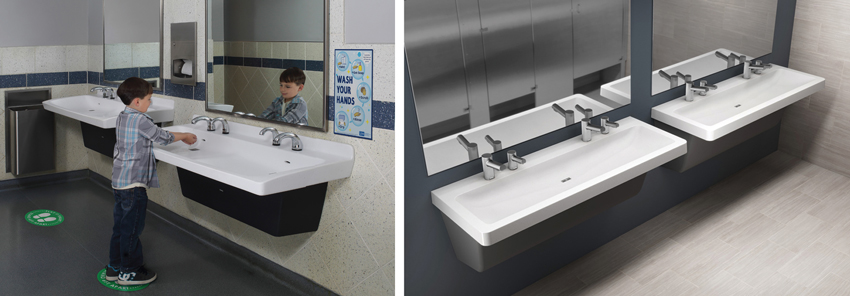
Photos courtesy of Bradley Corp.
Hygienic restrooms benefit from the use of touch-free fixtures that promote handwashing and contain water, soap, and drying functions all near the washing basin.
Notice
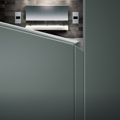
www.asi-accuratepartitions.com/privacy/

www.bradleycorp.com
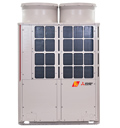
www.mitsubishicomfort.com/commercial

www.nanawall.com/generation4

www.rockfon.com









